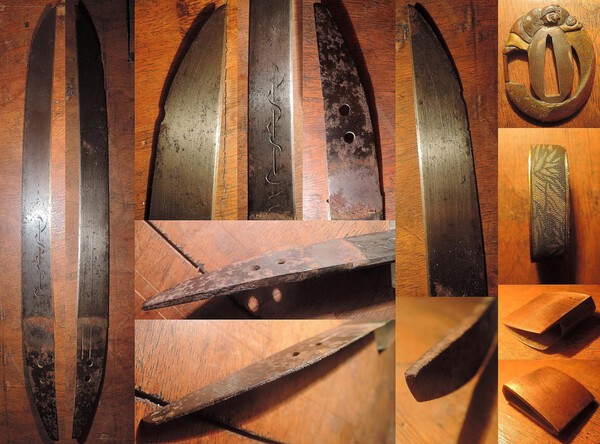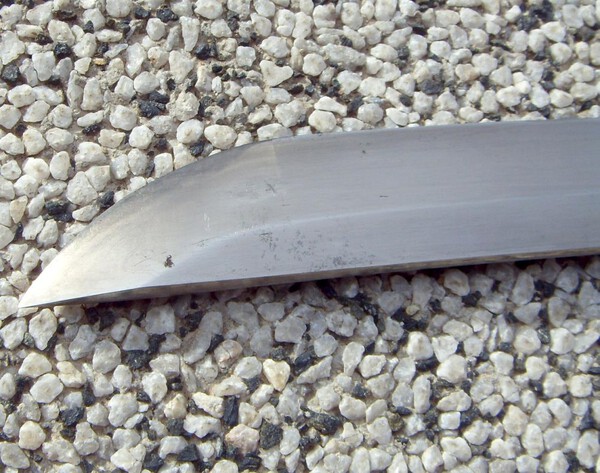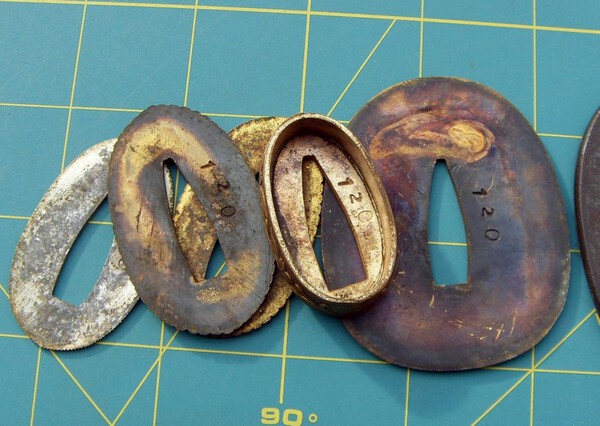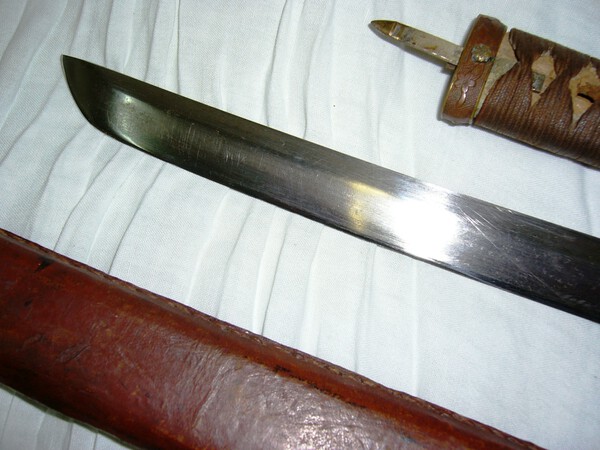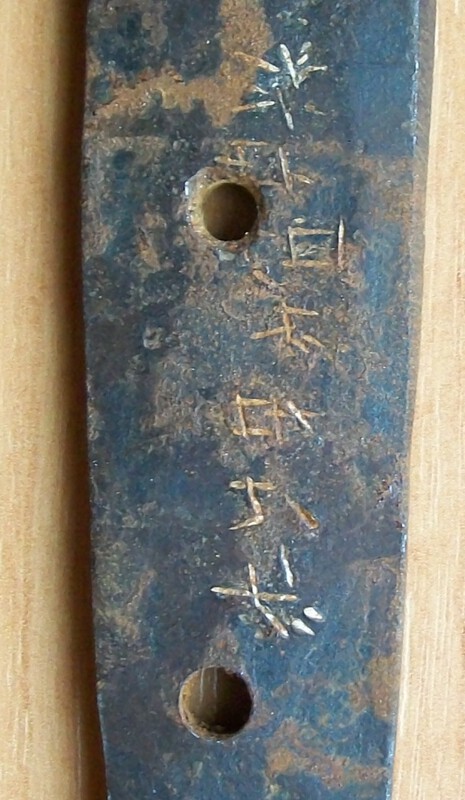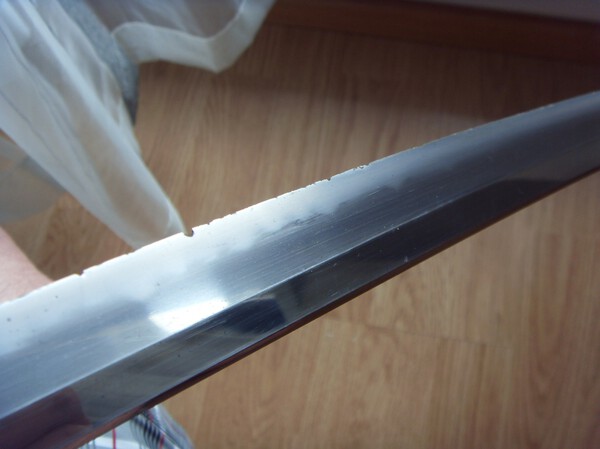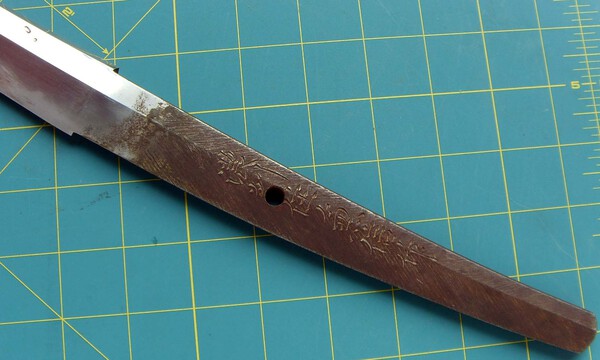
Photios
Members-
Posts
25 -
Joined
-
Last visited
Everything posted by Photios
-
Hello, Greg, thank you very much for the tip. Once more to the "garage sale" - in fact it was purchased at a local auction portal, where they normally sell items in quality of garage sale (that's why I called it so - otherwise the actual garage sales do not have a tradition in our country). Japanese swords are on this portal absolute rarity. So really it was a matter of chance and luck ... Regards Petr K.
-
Thanks for valuable advice - I will try to contact Czech nihonto club and maybe get some recommendation. Good idea. If the blade has such potential, so it is worth it. Petr K.
-
Gentlemen, once more again I thank everyone for their valuable insights and advice. I very much appreciate them. I must say that I was pleasantly surprised - I bought the blade cheaply. In truth I really thought about it that I'll try to polish the blade ... I'm surprised how much potential you see in this blade. To James: I'm from Czech Republic. Unfortunately in Central Europe I don't know any really qualified togishi. I'm going to look around. Petr
-
Hello gentlemens, I bought my first tanto (coincidence - garage sale). However, now I do not know how to classify it. I do not know if it's showa - or something older as would be implied by the remnants koshirae. I want to ask you for your views, feelings and insights. Measure of blade: Total length of the blade: 41.9 cm Nagasa: 31.0 cm Nakago: 10.9 cm Sori: 4.3 mm The height at munemachi: 31.5 mm The thickness at munemachi: 6.4 mm Eventual hamon is not possible to see - polish is completely consumed. Big thanks in advance. Petr K.
-
I know that about this swordsmith has already discussed on this revered forum and it was told that the only oshigata is in Kanzan's dictionary (but without any accompanying information). Unfortunately, I have not seen this oshigata. This Muneyoshi should be pupil of Muneshige (Hitachi no Kami Muneshige) from Sukehiro school. Most of his works is probably in the market presented with more famous names. Probably why are these on the internet so rare ... Petr K
-
Hello, Sebastien, thank you very much for your notice. Yes, it looks as the same smith. It's pity that oshigata of this master is not included in literature. Maybe only one - in Kanzan: Shinto Oshigata Dictionary. Unfortunatelly I have not access to this book. If anyone could share this oshigata with me, I would be very grateful to him. Otherwise, I am thinking to let polish my waki. I'm interested in what the blade is hidden in it.
-
Dear Gentlemen, I recently bought a wakizashi with signature "Settsu ju Minamoto Muneyoshi". I searched the internet for some reference material for this swordsmith, but unfortunately I did not find any papered examples of the work of this master. Therefore I dare to ask for your appreciation and suggestions regarding this mei. Probably it is gimei, but in my humble judgment rather well made. Sword itself is unfortunately totally out of polish. Shape of the blade including the original geometry are nice. Gentle work. My photos are too poor and do not show the true quality of the sword - I can not do better pictures. Any comments and information about Minamoto Muneyoshi will be very welcome. Many thanks in advance. Petr K
-
Coincidentally, now someone exposes sword with an identical signature on eBay. http://www.ebay.com/itm/Japanese-katana-sword-with-koshirae-tsuba-kashira-menuki-/200900230826?pt=Asian_Antiques&hash=item2ec6963eaa Sword maker is equally identified as Klaus did it. Regards Petr
-
Klaus, thank you for your opinion. I appreciate it. You've seen some sword of this swordmaker? Is mei similar? I mean unusual shapes of kanji. Thank you for your answer. Regards Petr
-
Gentlemen, please, I need help with the identification of another my sword. It's a classic showato with Showa stamp, traditional shape ww2 Seki swords, by oil tempered blade. If I read correctly mei, it is Noshu ju Kanemasa. Mei seems to me odd - the shape of individual kanji appears primitive, disheveled. On the other hand, I think that mei is not fake, it looks like old. If it's really Kanemasa, during ww2 were in Seki least 4 sword makers with this name. What do you think about the shape of mei and which from these Kanemasas belong to? Any ideas? Thanks in advance. Regards Petr
-
Further to our recent discussions - in the archive JapaneseSword.com I found a sword by Niwa Kanenobu father. Mei is almost identical and also the shape of the nakago. Although the sword bears the stamp Showa, the seller called it gendaito. And indeed - the blade has by water tempered hamon and seems also hada ... Very interesting sword. http://www.japanesesword.com/Images/Swords/08/608/608KAT7/608KAT7.htm Petr
-
Undoubtedly ... They pictures sent me seller. I did not buy this sword. Petr
-
Coincidentally, this week I was offered to buy this sword. If I read well: Bishu ju Masayasu kitau kore (Slough p. 108). For interest some pictures.
-
My concern was only to find out whether the inscription may have some content, or is it only "child scribbles." By sword alone I did not want to bother anyone on this forum - I know it's worthless. Regarding koshirae, I would disagree. All components are old and Japanese. But it does not matter - my question concerned only the inscription ... Anyway, thank you for your feedback. Petr
-
The blade is inferior, I feel that it is the work of a rural blacksmith maybe ... However, I am interested in the inscription - it is really strange. Petr
-
Hello, gentlemen, I have here a mystery. Is this Japanese or is it a message from aliens ? "Signature" is located on a poor sword which is at mounting composed of various components of various types of military koshirae. Any ideas? Petr
-
Gentlemen, once more thank you very much to all those who shared their experiences and opinions in this matter. I greatly appreciate it. I would like to ask you if you will met in the future with some examples of Niwa Kanenobu father's sword (or example of sword from the WW2 period with the same signature) so that you kindly share your discovery in this thread. Also would welcome any information on the person and work of Niwa Kanenobu senior. I will continue my personal research on this topic. Many thanks in advance. Petr
-
So now I got my new sword ... First impression: the sword definitely is not in the best condition, original wartime polish is dead, on the edge is a lot of nicks - and especially missing big piece of the tip of kissaki (likely work of some modern "samurais" who cut off completely anything ... ). On the other hand I like the overall shape of this blade - much finer than on most Seki blades from ww2 period. I tried to take a picture of the sword as best I could. I apologize for the quality of images. I'm not a studio photographer (definitely) ...
-
Unfortunately, at the moment the sword is still on the way from the retailer. Available to me is only a few photos that are not ideal ... Once the sword arrives I'll try to take some photos (do not know what is the result - I'm not a good photographer ). For now, at least a few images from the seller - but with great apology for their quality .
-
Kanenobu father used in his name almost the same second character like his son - that's an interesting information with regard to the information above. It appears that otherwise used a different spelling - at least when spoken with mentioned journalist. Petr
-
George, totally agree - the historical record is the best evidence for what form of spelling their names used both father and son Kanenobu. We no longer have to speculate ... Petr
-
Thank you Adam - I know this article of course. It is a very good tool for first exploring the theme of modern production of swords in Seki. However, no details about Kanenobu's father (or about other masters of Kanenobu named - except of Niwa Shuji Kanenobu) are not there unfortunately. By the way - just this article brought me to the idea that the signature of my sword could be signature of Kanenobu's father. Please note that the author of the article writes differently name of Niwa Shuji Kanenobu (兼延) and differently name of his father (兼信). I do not know where he gathered this information. Petr
-
Thanks again everyone for your opinions. It is certain that it will be necessary to perform a comparison with known specimens of swords by Kanenobu's father. But that will probably be a problem - until now I have not seen any such piece... To George: Thank you very much for a comprehensive search which you've done. Undoubtedly, it is the largest amount of information that I have seen until now in one place about Kanenobu's father. I appreciate your willingness. To David: I went through some older threads and found I was mentioning that on April 2010 you are owned gendaito by Niwa Kanenobu's father. Do you have some pictures for comparison? It would be very helpful.
-
Thank you gentlemen for your feedback. I very much appreciate it. Unfortunately I have no relevant literature to solve similar nuances. To George: Great thanks for your excursion into modern history of Kanenobu line. I did not find any similar information in the sources that are available for me. If I understood well, you have in mind this Kanenobu, about which writes Mr. Slough ("Kanenobu’s real name is Niwa Shuji and was born in April 1903, the second son of Kanenobu"). I have to admit that I already thought about that. Unfortunately about this master I not found any further information. Is it possible to know some details about the "Kanenobu father"? Has anyone seen his sword or signature? Any help would be appreciated. Petr
-
Hello, gentlemen, first of all big apology for my horrible English. I am a newcomer here, but I'm a long time reader of your great discussions. Thank you for the edification that it brings to me. I want to ask you for help and advice. I got the sword with this signature. It is in gunto koshirae. Sword is most likely from the ww2 period. On the sword are no stamps (Showa, Seki etc.). Sword is not dated. I read the signature as follow: "Noshu ju Kanenobu saku". But I do not know which Kanenobu it should be. If I'm right, Niwa Shuji Kanenobu use a different second character in his name (延). All swordsmiths named Kanenobu, who used the same character as is in the signature of my sword (信), are much older (koto, shinto). Is it possible that Niwa Kanenobu used two forms of writing of his name? Or is it some other Kanenobu? Can someone help me? In advance thank you. Petr


